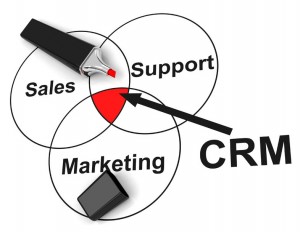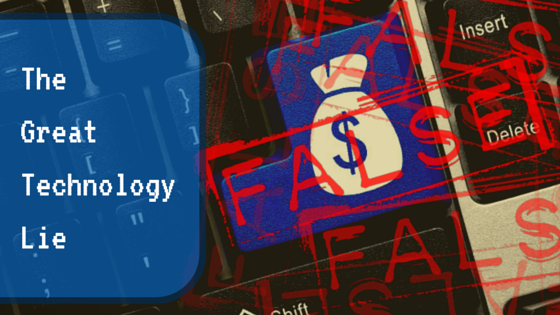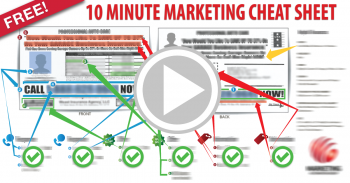Category Archives for Automation
Getting Started with CRM
 If you are an entrepreneur who is not currently using customer relationship management (CRM) software, you will be soon. Why? Because it saves you time and boosts your profits.
If you are an entrepreneur who is not currently using customer relationship management (CRM) software, you will be soon. Why? Because it saves you time and boosts your profits.
I am an expert on small business growth. My work with individual clients, and with groups, helps them become millionaires. Think about it—wouldn’t you like to make more money, and do more of what you love? At the same time, you can do less of what you don’t want to do. That could be done by someone—or something—else.
We talked last time about the different types of data and how data helps your business. But how do you manage your data in a meaningful way? That is where CRM comes in.
Learning about CRM is one of the first steps I recommend to my clients. Many small businesses get by initially by using a spreadsheet and an email list. Grow a bit, bring on a sales representative, or start getting some traction in the market, and you’ll find that keeping track of things on paper is not so easy.
Plus—storing dates, details, and customers is not the same thing as nurturing leads, activating your sales funnel, or engaging established customers.
Your CRM: What can it do for you?
In the last decade, the business of marketing has changed. While marketing used to be placing general ads, sending out brochures, and a hit or miss approach, personalization is the name of the game today. The better you capture individual consumer practices and preferences, the better able you are to meet client needs. How?
Your CRM software can handle a great deal of the labor that used to take marketing personnel many hours. From keeping track of important contact and sales information, to creating a dynamic web experience for new visitors to your website, CRM packages capture, store, and infuse your sales strategy with the information you need for leads to become conversions.
Here are some key capabilities of CRM software:
- Improve the view: With the move toward personalization, and a unique customer experience, one objective of CRM is a 360-degree client view. Because you no longer waste money on print ads, expensive brochures sent to a stale mailing list, or cold calls to uninterested consumers, the customer journey now takes center stage. When you use CRM software, you create customer profiles that allow you to segment your client base. Segmenting lets you create marketing plans for different client groups. CRM allows you to identify premium customers that pay more for the service, or product, you offer. Define those leads—or that portion of your customer base—and you have taken a first step to cultivating, capturing, and nurturing repeat business from high-margin clients.
- Keep clients on board: Customer retention is important. Spend less time creating new sales by maintaining your client base. Regular clients are more likely to buy more of your product line—and need less discount incentive to do so. Upselling is also easier with an established, satisfied customer. CRM software identifies those important clients, helps you schedule routine follow-up, and personalizes your relationship by noting important dates to send a card, gift, or discount offer.
- Targeting: Increase your revenue by ramping up your marketing strategy. By collecting data and creating focused campaigns, you push your sales message to leads, and customers, to sell your products and services. Your CRM software strengthens overall customer service since marketing and sales personnel have access to the same, fresh data. CRM software contributes to better service, higher standards, less intensive sales needs, and dynamic, focused sales campaigns. What’s not to like?
Can you take personalization too far?
Storing and using personal data can help you offer better value on a more personal basis, but be aware of some common errors using personal information:
- While most people appreciate the personalized touch, some people are concerned with privacy issues. Align your personalization with the relationship you have with each customer. Even if you have the information, resist the urge to walk up to a stranger in your store and greet them by name—unless they registered with your brand beforehand.
- Be careful of collecting information related to health, medical, or other concerns. Personalization could lead to large, hurtful blunders that could cost you a customer, and a black-eye, on social media.
- Use your data wisely. Personalized targeting works when it is appropriate, like when a potential customer is clearly investigating your website, and makes return visits. Consider this scenario—a person registers to download one whitepaper. They immediately receive one email, followed by scheduled, clearly canned emails that increase the intensity of their call to action with each email. They also receive unsolicited tip emails for which they did not sign up. Sound like good use of personalization? No thanks!
When you have questions about aligning your marketing data, business processes, and CRM software to boost your revenue, I hope you will call me at 585-633-7563.
Yours in profit,
Bob Britton
Business: Going Up! Going Down! What’s Behind the Numbers?
 One report says business start-ups have never looked better. Another survey talks about persistent decline. With the business outlook in churn, what do the numbers mean to you?
One report says business start-ups have never looked better. Another survey talks about persistent decline. With the business outlook in churn, what do the numbers mean to you?
While you focus on landing that client, or pivoting your marketing message, the economy is moving fast. Getting to market with a good plan, new ideas, and great products makes for a winner, but it is also important to understand your business ecosystem—is it healthy?
New reports: Do statistics lie?
Numbers are important to any business owner. Your bottom line, your profit margin, your price point—every number carries weight. In terms of business climate, let’s take a look at some overall reports:
The Brookings Institution: This organization recently released a study on business dynamism, the churn that occurs when companies start-up, succeed, grow, or fail. Its findings include:
- Statistically, a new business starts each minute, while another fails every 80 seconds.
- Business dynamism, the growth and decline of companies in the private sector, has fallen for years.
- Reduced dynamism results in slower economic growth.
- New regional and national measures are needed to fuel small business growth.
Kauffman Index: According to a study from the Kauffman Foundation, 2014 saw the strongest entrepreneurial growth since 2010. Some interesting entrepreneurial points include:
- Most new small business owners are men, at approximately 63 percent. According to the report, the rate of new female entrepreneurs is near a two-decade low.
- Called opportunity entrepreneurs, owners who are not unemployed—and starting a business by choice—represent the largest number of new small business owners, at more than 79 percent.
- Up from just over 13 percent in 1997, immigrant entrepreneurs now account for more than 28 percent of new small business owners.
Notes Kauffman study author Arnobio Morelix, “When broad-based entrepreneurial opportunity improves at this pace, it’s an indication that the labor market is slowly recovering.”
Global Entrepreneurship Monitor (GEM): GEM is a joint collaboration involving more than 69 countries and conducts research on entrepreneurship around the world. Some GEM data on American entrepreneurs includes:
- In the United States, there are approximately 24 million entrepreneurs, representing about 14 percent of the population. This represents a high-water mark for the 16-year GEM study.
- More than six percent of start-ups currently occur within organizations—meaning entrepreneurial efforts are being supported through, and by, larger corporate environments.
- Of the surveyed countries, the United States reports the highest number of entrepreneurs between ages 55 and 64 years of age.
- Twenty-one percent of entrepreneurs expect to create 20, or more, job positions in the next five years.
Why do numbers matter?
With absolute certainty, I can say these reports agree on one point—it remains an unsteady business environment. The confluence of economic indicators, new jobs, oil prices, and global politics play an important role in the local business environment where you operate your company.
I work with entrepreneurs to maximize the profit they earn—or will earn when starting up a new business. In the initial one to three years of your business lifecycle, the seeds of success and failure are sown. When I work with business owners, we look at expansion—or contraction—when needed, or replacement of outmoded operations with lower cost marketing automation to reduce labor and time expenses.
To gauge risk and support growth, it is important to keep an eye on the economic climate for a couple of reasons:
- Knowing the cost of goods is important. The Producer Price Index (PPI) looks at the cost of goods and materials for manufacturers and producers. When the cost of materials goes up—you need some savvy to understand whether you should raise your prices, or hold on. Keeping an eye on the overall cost of materials helps you plan and price.
- In August, the overall employment picture did not change much, with some states reporting job loss—others reporting job gain. Regional and national unemployment trends are important to entrepreneurs. National rates give you a birds’ eye view of a larger cycle. Regional rates give raw information to plan for temporary downturn, or uptick in customer spending.
- In any particular season, it is good to know about consumer confidence. By some measures, 45 percent of reporting households noted a better financial picture in August of this year. When consumer confidence is up, your clients and customers may spend more. At present, recovery from the Great Recession continues, with bumps from volatility in the stock market, and oil prices.
What’s in a number? Plenty. When you want to understand your bottom line—and boost your income—call me at 585-633-7563.
Yours in profit,
Bob Britton
Don’t “Should” on Yourself—Delegate!
 You are at your desk and it is stacked with things you should do. They’re weighing you down—
You are at your desk and it is stacked with things you should do. They’re weighing you down—
and crushing your productivity. What can you do?
Don’t should on yourself. When faced with tasks you do not have the time, or skill set, to pursue, give yourself a pass. Here’s why.
As an entrepreneur, you are the captain of your ship. At the helm, you have overall responsibility for the business and your strategic plan. This means you are not at the oars, the galley, or rigging. When you lose your focus, your business goes off course—or possibly sinks like a stone.
If you cannot do everything, who can?
Delegation and the small business owner
Trying to handle business goals outside your expertise and interest is exhausting and time consuming. As we discussed earlier, entrepreneurs must undertake the responsibilities only they can handle—without feeling guilty about not doing everything else.
If it worries you to hand off some of your business function to others, consider the real benefits of diversifying your workload:
- No need to be a jack of all trades: Part of your role as an entrepreneur is doing what you do best. You have ultimate responsibility for the quality and positioning of your brand, products and services. I have said it before, and I will say it again—do only what only you can do.
- More heads are better than one: When you delegate, you work with people with the skills, or the time, to handle tasks you cannot, or should not, be doing. Working with specialists, consultants, advisors, or your own team opens problem-solving to others with experience and creativity.
- Better base: Work with a team to stabilize your business and take advantage of individual strengths. As you grow your company, offload the pile of shoulds on your desk to people qualified and ready to handle them. Individual and business productivity increases as you—and members of your team—each manage core tasks.
- Scalability: Market readiness means your business can respond when opportunity presents itself. Identifying if—and how—your business can respond to a profitable idea means exploring scalability. Developing capable, reliable external resources allows you to delegate needed services to take advantage of market circumstances.
What types of tasks can you delegate?
Consider these tips when you think about what you could delegate:
- Business direction: Strategic planning, focus, and business direction are important responsibilities for small business owners. You can use consultants, mentors, and business groups to inform and shape your perspective. Critical business thinking is your job.
- What is your passion? In theory, you started your business to do what you love, and make a living at it. Identify what tasks are part of your skill set and that you want to perform.
- Essential services: Bookkeeping and payroll are among services that can be cost-effectively outsourced. Websites, blogs, and online marketing can be managed by social media specialists. Use marketing automation to build leads, increase customer loyalty, and save yourself time.
Delegation looks different for each company. I work with entrepreneurs to create business plans and technological solutions. To coach small business owners from making in the low six, up to seven figures, I provide focus and create solutions that save them time and money.
Some modes of delegation for a small business owner can include:
- Advisor or mentor: Work with an outside expert, mentor, or coach to create strategy, and manage market and business bumps.
- Consultant or contractor: Use a consultant or contractor for project management and coordination, to handle marketing, or to perform other tasks. Consultants offer high quality, scalable service.
- Hire: Use temporary or permanent hires to fulfill identified needs.
Think about delegating tasks and services before you become overwhelmed, and your services suffer. Keep the following pitfalls in mind:
- Putting it off: When you know you are overcommitted, get help and think about delegation. Do not procrastinate.
- Avoid wrong choices: A trusted business group, mentor, or associate is a valuable source of business referrals. Due diligence is a must when you are looking for contractors to help with your business.
- Stay away from micro-management: Whether you delegate to a trusted employee, or a reliable contractor, try not to micro-manage.
When you have a lot of things to do—and you know you are not going to do them—stop shoulding on yourself. Spend time thinking about your business, and move forward.
When you want to make more money doing the things you love to do, and you need focus—call me at 585-633-7563.
To your success.
Bob Britton
SOS: Beware Shiny Object Syndrome!
You just heard a great idea. You have to try it. It doesn’t really fit your business model and is beyond your core competencies—but, guaranteed, you will make a fortune.
Stop right there. All that glitters is not gold—for a lot of reasons.
Good for crows but bad for small business owners, Shiny Object Syndrome (SOS) is hazardous to the health of your business. Consider these examples:
- You have a proposal to submit to a long-standing client. You have a good relationship with your client and the proposal is a sure thing. You are working on it when an email comes in with marketing tips that promise to make you more money. Buy this, learn that, earn more. You buy it hook, line, and sinker and use your new-found wisdom to change your proposal pricing. You submit the proposal—and the client goes elsewhere.
- At a conference, you learn of a great program to motivate employees and increase productivity. You buy in. A consultant charges you a lot of money to study your company and train your employees. Six months down the road, no one remembers the concepts, productivity is the same, and the only difference is the financial hit.
- New marketing software—you must have it. Your digital marketing guy must have it, too, even though it is totally wrong for your business objectives. You buy it, deploy it, and watch it fail.
Whether you run a small business or a large corporation, everyone is vulnerable to shiny objects. They are pretty and promising. They are new and cool, swag for the business suite—and they can be a serious problem.
Take a breath and slow down
Distraction costs time and a lot of money. Each new email that interrupts your train of thought, or each freshly-pressed idea that disrupts your business plan, can distract you from achieving your business goals. Distraction keeps small business owners from succeeding in ways that include:
- Continually trying new ideas, methods, or software may become your version of business management. Eventually, you think, you will hit on the right combination, the perfect idea, the dream product.
- Your business could be in financial trouble. You hit a slump and need something new—somewhere. A turnaround company says it helps businesses just like yours. You cannot afford another mistake.
- Your small business is doing okay. You want more profit. Someone said try this new off-the-shelf inventory system—sounds like a good idea.
Distraction fragments your attention, diminishes your budget, and shows little return on investment—if you are even tracking ROI. All these examples point to entrepreneurs who do not see the big picture.
My job is helping small business owners see the bigger picture, make more money—and become successful. That means knowing which shiny objects to pick up—and which to leave behind.
How do you know what works?
When I meet with a small business owner, I ask ten strategic questions. Ten. Within 30 minutes, we get to the heart of their problem. After that we build a solid plan to create traction toward business goals. Distraction is not part of the deal.
How can you safeguard your business and your time against the distraction of shiny new things? Consider these tips:
- Too good to be true: What was true yesterday remains true today. If it sounds too good to be true, it probably is.
- No rush: The cutting edge of technology is a popular, and profitable, place to be these days. Nonetheless, there is no rush to try out new ideas or technologies before others use their time and money to do it for you.
- Use good business sense: Have you previously identified an issue this technology or process can address? Will this opportunity or start-up increase value to your client or customers? Does this innovation apply specifically to your industry, or would you need to reinvent it? If it passes muster, consult with business associates, or join a small business support team to discuss whether it is right for your big picture.
- Repeat after me—no rush: No offer, no product, and no process is so rare you cannot wait to research the idea and confer with others. If you are pushed for a decision, leave the shiny object for someone else to play with.
Innovation is changing the way we live and work. The other part of my business is creating unique technical solutions for entrepreneurs to meet their identified marketing needs, offer value to their customers, and increase their profits. When appropriate, the deliberate use of innovation is desirable—not distracting.
When you want to make more money, forget the shiny object and call me at 585-633-7563 for the business plan you need to achieve the profit you want.
To your success,
Bob Britton
Nature and Nurture: Grow Your Business through Marketing Automation
Marketing automation is a key differentiator between successful and struggling businesses. Let’s talk about how you can use today’s cutting-edge technology to nurture new leads and grow your business.
What is marketing automation?
As a business person, you already know the importance of marketing to build and maintain your client base. Marketing automation (MA) is the strategic integration of software and services. It saves you time, helps you develop prospects, and enables you to maintain the one-to-one customer contact so essential to satisfying clients and increasing your revenue.
MA is an essential aspect of customer relationship management (CRM) and offers some vital benefits:
- Time management: Whether you own or manage a small business or large enterprise, you can benefit from the time and production efficiencies provided by automation tools that help you manage social media, leads, referrals, and much more.
- Staffing: The time savings offered by software tools enables you to reduce staff and more productively utilize employees. By using software to handle labor-intensive tasks, you can strategically refine your human resource planning and marketing spend.
- Be effective: Marketing automation makes it possible for you to do more with fewer resources. For example, triggered email can save a sale, thank a customer, or remind a former client of the important services you offer. Triggered transactional emails contribute to conversions and help you partner with your clients rather than just push a sale.
- Build your brand: Use less effort to increase your profile. Automated tools can monitor your brand online or create multi-channel marketing campaigns. Consistent visibility keeps your brand fresh and improves inbound marketing opportunities.
- Analytics: You can gain value and conversions as you create and maintain client touch-points throughout the sales cycle using MA. At the same time, you can collect intelligence to refine and redeliver your message or a sales incentive.
Automation is only half of it
According to a study by the Lenskold Group, companies that use integrated marketing automation are more likely to report successful sales efforts. These companies also have a greater expectation of growth than companies who do not integrate MA with their CRM system. But is “set it and forget it” all there is to marketing automation?
The answer is no. While marketing automation helps you gauge and deliver the right message at the right time to make a sale, or sustain a relationship, it is only part of the picture. Although wrapped in leading-edge technology, sound marketing principles remain. Successful marketing still means:
Offer a product that is affordable and desirable to your target market
- Sell through the channels most likely to succeed
- Create a clear offer and well-tuned message
- Treat customer feedback like gold
At Marketing Automation Group (MAG), we couple MA strategies with strong support and training to help business owners expand their profit potential. Professional success grows from nurturing your knowledge of people and businesses. Whether you are a B2B or B2C enterprise, the personal side of marketing was never more important—or more accessible—than through the use of MA.
Why are nurture campaigns important?
Personal touch is at the heart of marketing automation. Processes like lead scoring and customer segmentation contribute to your ability to see what your customers like. Effective feedback surveys let you know what your client does not like.
On a personal level, MA lets you reach out and touch clients in ways that offer value and ongoing relationships. Consider these techniques:
A follow-up email offers a thank you for a purchase
- A card or small gift sends birthday greetings
- An email or discount incentive enlivens a business relationship gone stale
MA requires a focused message and skillful use of technology to save time and help you cultivate good business—and human—relationships.
Achieving Success
How can you achieve success through MA? According to Gleanster, a few challenges to overcome include:
Marketing automation loses luster when it is not used correctly or integrated in a bigger strategic picture. Companies using MA fall short of expectations when employees or management lack training or support to achieve their desired results.
- Reliance on old methodologies or marketing attitudes reduces the benefits of MA technology. Use of large market email lists, rather than refined subsets, defeats the delivery of the right message to the right consumer.
- Metrics are important for benchmarking success—or the need for a different strategy—but may not be developed prior to deployment by overwhelmed staff or business owners.
Marketing automation is not magic. It involves leveraging tools, strategic thinking, and the right message-to-market match. Do not struggle when you can succeed. If you are a business owner ready to gain the skills and support to reach for your dreams—talk to me today.
The Great Technology Lie…
Alright, I’ve had enough! I can’t take it anymore. It’s time to set things straight. If I see another person sending me emails saying ‘double your sales in just 1 week’ or $17,000 in only 2 hours, or any other crap like that, I’m going to spit!
I’m sure the people sending this stuff are good people, that’s something I tend to believe (that most people are good), unfortunately, these people have succumbed to the great lie that is so pervasive today. It’s the lie being told by so many people that it’s almost starting to feel true. You see it everywhere, on Facebook, on twitter, in your email inbox, on webinars.. it’s literally everywhere.
What is this great lie?
That technology (in any shape or form – CRM systems (Infusionsoft, Ontraport, ect..), Webinar platforms, video hosting, blah, blah, blah…) can build your business. Don’t you believe it!!!
Now, being that I’m a former Infusionsoft Ultimate marketer myself, you might say, WTF? How can I say that? When in point of fact, Infusionsoft did help me triple sales at my business.
Here’s where I’m coming from. After winning the award, I decided to start helping other business owners implement this amazing technology into their business. After about 4 years of working with people, trying to teach them to use this technology more effectively, you know what I’ve discovered?
About 95% of the people that buy these technologies aren’t ready for them at all, most bought them to solve a problem with their business that technology in and of itself CANNOT fix.
Problems like:
Poor to non existent delegation skills
Trying to do everything themselves
No assets (money or otherwise)
No management skills
No clear offer
No clear target market
Poor messaging
And a lot more….
You see, the REASON I was able to triple sales at my business is because I already had clear offers, a clearly defined target, and kick butt messaging, BEFORE I added the technology to get that message to the right person at the right time. If you LISTEN to all of the people who have been finalists for the Ultimate Marketer (or won it), they ALREADY HAD these key things in place before getting the software. Take that a step farther, and I’d say ALL the people who have done well on the web, have these things figure out as well.
At the end of the day – the technology amounts to about 10% of the overall puzzle. It’s NEVER the technology that creates the buying frenzy – it’s the message to market match. The other 90% of success is a combination of high brain activities like crafting a clear offer, and figuring out how to reach your target cost effectively and a lot of the list above…
If you truly want to be successful, as quickly as possible, then focus your learning on these high brain, high leverage activities and you’re success will be all but guaranteed.
Continue to buy into the lie, and you’re destined for a life of struggle and strife.
– Bob
P.S. Want a program designed specifically to teach you how to master these skills? Check out my webinar (you can register here), or just sign up here.
Your mail will never get opened… Unless you do this
 Hi Business Owner,
Hi Business Owner,
My name is Bob Britton, a fellow small business owner and President of Marketing Automation Group.
When most people get their mail they divide it into 3 piles:
Pile A: Personal mail.
Pile B: Bills.
Pile C: Everything else, AKA junk mail.
And you know what happens to junk mail… It goes in the trash without ever being opened.
If you want your letter to get opened, then you can’t send out the same stuff most businesses do. Instead of going for a “professional, polished” look, you have to make your letter look like it’s personal mail; like it is coming from their little old grandmother.
You do this by hand writing the address, using a stamp, (not metered,) and using colors. More people will open your letter if it looks personal than if it looks like something automated and from a business.
Think about yourself when you open your own mail; wouldn’t you be more likely to open something that looks like a note from a friend rather than just another flyer for a local business? If you send a letter and nobody opens it, then your marketing effort, (and TIME, and MONEY,) was totally wasted!
If you have any questions, need some immediate advice, or are interested in talking about other ways to make the most of your marketing budget, please give me a call at 585-633-7563.
To your success,
Bob Britton
Did You Know That Direct Mail Is The Cheapest Methods To Get Customers?
Did You Know That Direct Mail Is The Cheapest Methods To Get Customers?
Hi Business Owner,
My name is Bob Britton, a fellow small business owner and President of Marketing Automation Group.
Direct mail is one of the most powerful ways to market your business that there is.
This year there will be $32.4 billion spent on direct mail. Barely $11 billion will be spent on cable TV advertising for the top 6 TV networks. These statistics are according to a study directed by McCann-Erickson.
There wouldn’t be that much money spent on direct mail if it didn’t work.
So why do most small businesses, especially businesses, think of direct mail as a waste?
They don’t know how to use it. They’ve never had any instruction on how to use it.
They send a flier- as you know by now, 99.9% of fliers don’t cut it
they send it to a ‘bad’ list. The list, the people who you send your letter to, is just as important as the letter itself.
Many people overlook this.
One business owner had written a sales letter. It was pretty good, not great but pretty good.
She was getting zero response, not low, not one but zero. Zilch. Nada.
Who was she sending her letters to?
She didn’t know. She had bought a zip code zone.
Finally she went to look at the houses in the zip code she purchased.
Let us describe it for you:
Run-down. Tiny houses with broken down porches- at least one plank of wood was missing. Junk strewn across the front yard. In the driveway there was a car on cement blocks with half the engine removed. Both the husband and the wife were wearing stained t-shirts.
Are these the types of people most likely to buy your services?
Do they even own a computer? If they do, would they pay to get it cleaned?
These people are not good prospects for you.
The List is very important.
To recap, here is why most It business owners fail at direct mail:
No direct mail expertise.
Bad sales letter
Bad list.
How To Do Successful Direct Mail
Have an irresistible offer. The more enticing your offer the better you will sell.
Attention getting headline. Your headline is really an ad for your sales letters.
Create Interest. The first paragraph should emphasize the benefit to the reader, this gets your prospect interested enough to read the rest of the letter.
Create desire. Make your prospect really want what you’re offering.
Call to action. You must have an irresistible offer.
You must tell the prospect to respond and have a deadline. If you don’t tell the person to call today and don’t have an expiration date creating a “sense of urgency” you don’t have a direct response.
In our program there are lots of ready to use direct mail letters. Use them as-is or modify them. Learn from them and start writing your own!
If you have any questions, need some immediate advice, or would like to get involved with my program please give me a call at 585-633-7563.
To your success,
Bob Britton
Zombification
Good Morning Business Owner,
My name is Bob Britton, a fellow small business owner and president of Marketing Automation Group.
I’m going to teach you how to raise the DEAD. It’s called Zombification.
Why are you laughing?
Hey we ALL have dead customers. Not Dead Dead – I mean customers that don’t come into your store or call you for an appointment anymore. It happens. Sometimes their needs change; sometimes their financial circumstance change, and sometimes, we change.
BUT the end result is a customer who stops coming in and buying from you. Which is awful because we all know the effort it takes to get a customer in the first place?
Now I don’t want you to feel bad about NOT doing this stuff, but… Guess how many business owners have an active “Customer Reactivation” plan?
1 in 100… maybe…
I’m going to show you exactly what to say to a dead customer so you can zombify them. Remember, Zombies are the living dead – Zombification helps them find their wallets again. By-the-way, How’s this analogy working for you?
You might not even KNOW your customers are dead because you haven’t established a standard for dead-ness. So, first things first – we need to make a list of who’s dead and who’s not.
Answer this question – How often do your customers come into your store or call for service on their computer? Is it every 2, 4, 5, or 6 months.
The amount of time I use to determine if a customer is dead is 12 months.
Why?
Because I have customers who come in every 3, every 4, every 5, AND every 6 months. So if a customer doesn’t come in my business in 12 months they have missed at least 1 visit if they usually come in every 6 months.
So we have established a “DEAD” customer if they have NOT come into your store or you did not service their computer in say 12 months. Or you may just know they are dead, just making sure that you would consider them DEAD.
Now, to that list of dead customers, I want you to send them a letter that says the following. If you have their email address, send them and email.
I almost forgot – I hope you have the ~Contact.FirstName~s and addresses of all your customers. If you don’t you can’t do this. So PLEASE for your own sake START getting the ~Contact.FirstName~s, address and email addresses of all your customers when they come in or you go to them. Just have them fill out a form.
Dear Client Name,
I want to sincerely thank you for all times you have (come into our store) or (allowed us to service your computers) and for all the business we’ve done together in the past.
However, (this is important, because “However” sound grave), I recently noticed that we haven’t seen you in quite a while. I was hoping to find out why.
Perhaps we’ve done something wrong – and if we have, I’d like to know what that is. This way, maybe we can fix it for you, but certainly I can make sure it won’t happen again to anyone else.
(Now this is IMPORTANT)
Also, I wanted to make you aware of a (New product, service, or upgrade) that we’ve just rolled out.
Because you’re an important client, I wanted to extend to you a (some kind of reward, discount, something extra) on this (new product, service, or upgrade)
Committed to your success,
Jane Doe
ABC Business
123 Any Street
Any City, 12345
P.S. Please give me a call anytime at 123-4567 and I hope to see you soon.
NOTE-You MUST make them an offer. Make it as good you’re reasonably able to do.
Now, let me tell you why you probably won’t do this. You’re thinking that you’re going to make them upset. You’re thinking that if YOU got a letter like this that you’d turn on the paper shredder.
Question – there are business owners and there are clients – which are you? Do you think you are normal? Uh HELLO! You RUN A BUSINESS. That makes you ABNORMAL.
Remember, we’re not like most people. We’re different. NEVER assume that you are a model of your client, because you are not, and you never will be. So you CAN”T draw an analogy between your thoughts, behaviors, and choices and theirs.
Please GET this; Even IF they turn on the paper shredder – they were dead ALREADY, You’re not in danger of ruing a relationship with a dead client.
If you have any questions, need some immediate advice, or would like to get involved with my program please give me a call at 585-633-7563.
To your success,
Bob Britton







